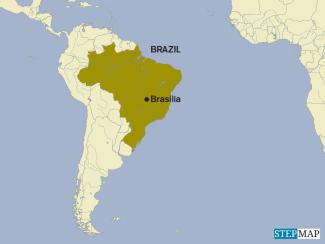Forced labour
Slavery in all but name

According to Brazil’s Secretariat for Social Security and Labour, between 2003 and 2018 authorities freed some 45,000 workers from slavery-like work conditions. That translates to an average of more than eight workers rescued each day during the 15-year period. A further 1,054 de facto slaves were rescued in 2019 from 111 different workplaces.
Freed workers tend to be internal migrants. Many left their homes to search for work in agricultural growth regions. They find work in caring for livestock, producing coal, cutting trees and cultivating crops such as sugar cane, soy and cotton. But new arrivals are charged money for their jobs, thereby sinking into debt before receiving their first wages. They work long hours without paid rest periods. In some cases their workplaces lack toilet facilities.
Slavery occurs mainly in remote rural areas with few transportation routes enabling escape. The state of Minas Gerais in southeastern Brazil had 849 rescued slave labourers in 2018, followed by Pará in the north, with 159 rescues.
The problem of slave labour in Brazil became prominent in December 2020, when a domestic worker was rescued following 38 years of working under slave-like conditions. Madalena Gordiano, a 46-year-old Black woman, had worked in slavery-like conditions since the age of eight.
Her case became known after she knocked on the door of a neighbouring family and asked for food. The family took her in and notified the authorities. The case caused an outcry throughout Brazil.
What emerged was that she had been taken out of school and forced to do unpaid housework in exchange for housing, food and clothing. She slept in a small room without a window and had no cell phone or television. Her only belongings were three T-shirts. She was forbidden to talk to neighbours. However, some knew of her situation because she put notes under doors asking for money to buy soap and other personal items.
Most of the victims of de facto slavery in Brazil are men between 18 and 24 years old. They are likely to be illiterate or at least to have had only a few years of school. Specifically, 31 % of those rescued by national authorities were illiterate, and 39 % had not completed their fifth year of school.
According to the national authorities, 80 % of workers rescued from slavery-like conditions between 2016 and 2018 were Black. The rescued Blacks were mainly men (91 %), aged 15 to 29 (40 %), and originally from northeastern states (46 %).
Speaking at a signing ceremony in 2019 for new occupational health and safety regulations, President Jair Bolsonaro said it is the responsibility of the national Congress to pass laws enforcing the existing ban on slave labour. But in November 2020, he rejected a measure to seize the lands of landowners whose workers live in slavery-like conditions. So these conditions persist, even though slavery was formally abolished in 1888.
Thuany Rodrigues is a journalist in Brazil.
thuanyrodriigues@gmail.com









